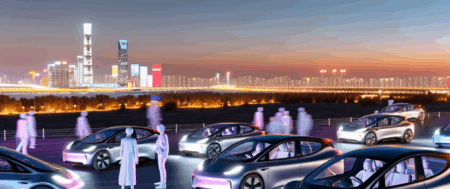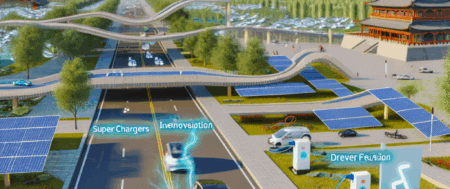In China, the world’s largest automotive market, both foreign automakers and domestic car brands are navigating a complex regulatory landscape to tap into opportunities driven by a growing economy, urbanization, and environmental concerns. The push towards Electric Vehicles (EVs) and New Energy Vehicles (NEVs) is central, supported by government incentives. To succeed, foreign players often form joint ventures with local firms, leveraging strategic partnerships to meet consumer preferences and align with regulatory demands. These collaborations are crucial for sharing technological advancements and facing intense market competition. Adapting to regulatory shifts, understanding consumer needs, and embracing innovation through partnerships are key for thriving in China’s dynamic automotive sector.
In an era where the automotive industry is rapidly evolving, the spotlight has firmly settled on China, the world’s largest automotive market. This titan of industry is not just leading in terms of production and sales but is also at the forefront of the seismic shift towards Electric Vehicles (EVs) and New Energy Vehicles (NEVs), propelled by a combination of government incentives, environmental concerns, and a burgeoning consumer demand. As the heart of global automotive growth, China’s market is a complex tapestry woven with regulatory challenges, technological advancements, and an ever-expanding middle class fueling urbanization at an unprecedented scale.
Foreign automakers and domestic car brands alike are finding themselves at a crossroads, navigating through the intricate regulatory landscape and forming strategic partnerships and joint ventures to tap into this lucrative yet challenging market. The drive towards green, underscored by a significant push for EVs and NEVs, is not just a trend but a testament to China’s commitment to steering the future of the automotive industry. This dynamic environment, shaped by consumer preferences, government policies, and market competition, offers a unique glimpse into the future of transportation.
In this comprehensive exploration, we delve deep into the facets that make China’s automotive market the powerhouse it is today. From understanding the regulatory landscape that governs the largest automotive market in the world to decoding the consumer preferences shaping this dynamic industry, the article offers a detailed analysis. We examine the impact of urbanization, the growing economy, and how technological advancements are fueling the competitive edge among top players. Moreover, we highlight the significance of joint ventures between foreign automakers and domestic car brands, and how these strategic partnerships are pivotal in navigating the complexities of the Chinese market. Join us as we embark on a journey through the fast lanes of China’s automotive industry, where innovation meets tradition, and environmental concerns drive the transition towards a greener future.
1. Navigating the Terrain: Understanding the Regulatory Landscape of the World’s Largest Automotive Market

Navigating the intricate regulatory landscape of China, the world’s largest automotive market, is a cornerstone for both domestic car brands and foreign automakers aiming to harness its vast potential. The burgeoning middle class, spurred by a rapidly growing economy and significant urbanization, has catapulted China to the forefront of the global automotive industry. This expansion is not only in traditional vehicles but is especially pronounced in the sectors of Electric Vehicles (EVs) and New Energy Vehicles (NEVs), driven by strong government incentives and mounting environmental concerns.
The Chinese government has played a pivotal role in shaping the automotive market through a series of regulatory frameworks and policies aimed at promoting sustainable development. These include substantial subsidies for NEVs, stringent emission standards, and mandates for automakers to produce a certain percentage of zero-emission vehicles. Such regulatory measures have significantly influenced consumer preferences, gradually shifting the market towards greener alternatives.
Foreign automakers looking to tap into this lucrative market face a complex regulatory environment. Joint ventures with local Chinese companies have become a strategic pathway for these international entities, not only to navigate the regulatory maze but also to tap into the local knowledge of consumer behavior and market dynamics. These partnerships are crucial in aligning foreign brands with China’s market requirements and consumer expectations, thereby facilitating smoother market entry and expansion.
Technological advancements further intensify market competition, with both local and international players racing to innovate in EV and NEV technologies. Strategic partnerships extend beyond mere market access; they are essential for sharing technological know-how, research and development (R&D) capabilities, and for jointly navigating the evolving regulatory landscape.
The competitive edge in this dynamic market relies heavily on understanding and adapting to the regulatory nuances, consumer preferences, and leveraging government incentives to foster innovation in electric and new energy mobility solutions. As the Chinese automotive market continues to evolve, staying abreast of the regulatory changes, embracing technological advancements, and fostering strategic partnerships will be key for automakers to thrive in the world’s largest automotive market.
In conclusion, the Chinese automotive market, standing as the world’s largest, presents a unique blend of opportunities and challenges for both domestic car brands and foreign automakers. Navigating the complex regulatory landscape, understanding evolving consumer preferences, and leveraging strategic partnerships are essential for success in this dynamic market. With its growing economy, rapid urbanization, and a significant shift towards electric vehicles (EVs) and new energy vehicles (NEVs) driven by environmental concerns and government incentives, China is at the forefront of automotive innovation and market trends.
The emphasis on EVs and NEVs highlights the market’s response to global environmental concerns and showcases China’s leading role in the green revolution within the automotive industry. Joint ventures between foreign automakers and local Chinese companies have become a strategic necessity, enabling access to the vast consumer base while complying with the regulatory framework.
As the market continues to evolve, driven by technological advancements, the competitive landscape becomes increasingly intense, with both domestic and international players vying for dominance. Understanding the largest automotive market’s intricacies, from the regulatory environment to consumer trends, is crucial for any entity looking to make its mark in China. The future of the automotive industry in China is poised for further growth, influenced by the government’s policies, market competition, and the continuous push for innovation. Success in this lucrative but challenging market requires a deep and nuanced understanding of all these factors, highlighting the importance of adaptability and strategic foresight in navigating the vibrant automotive landscape of China.







